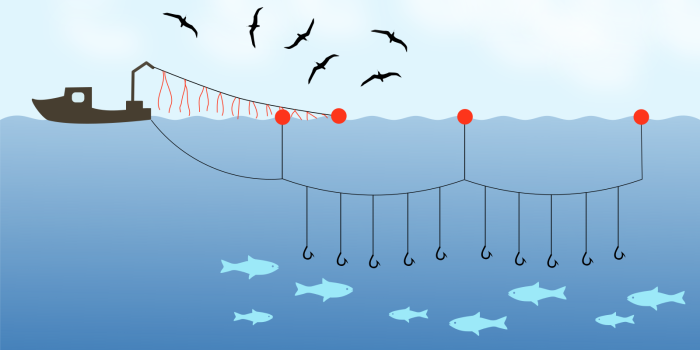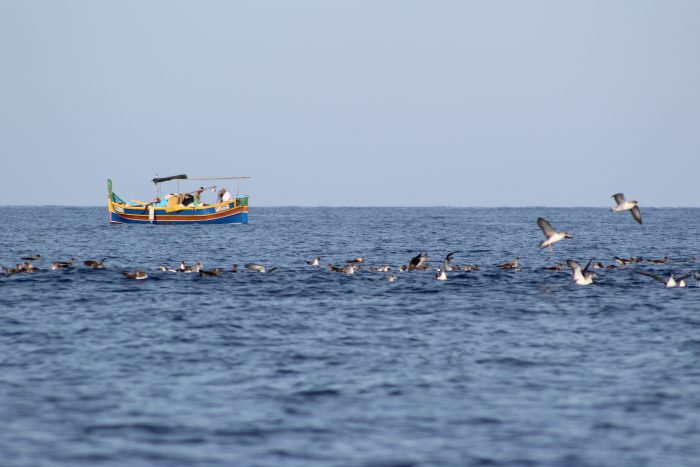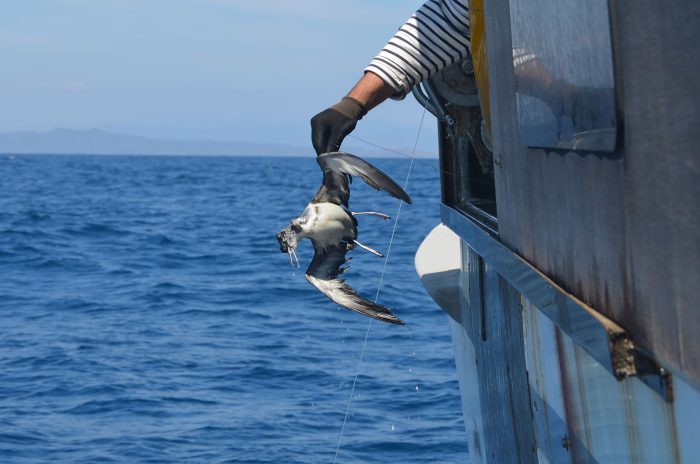The Mediterranean coastline saw the beginning of civilisation and ever since its population never ceased to increase until our modern times. The inhabitants of the Mediterranean have a high demand of fish products, which was always a central element of its renowned cuisine. Fisheries have always been a source of livelihoods in this region, not only for fishers but also creating a range of economic benefits for tourism activities, restaurants and boat builders.
A pressure for the marine environment
This dense population has different impacts on the marine environment. The Mediterranean Sea is a unique ecosystem, but the threats weighing on it are increasing. Among those threats, there are climate change, urbanisation and habitat degradation, ocean acidification, plastic pollution and the proliferation of invasive alien species.
The increasing pressure from fishing activity is among these threats and together they pose a serious risk for the marine ecosystem, and on the thousands of people depending on a healthy sea. Despite the damage from the industrial overfishing, the small-scale fishermen, who represent the majority of the workforce, find themselves in a vulnerable position. It is essential to support their livelihoods and resilience. Especially when the small-scale fishers contribute to multiple socio-economic benefits like food security, development of coastal communities and employment (FAO. 2022).
In the meantime, fisheries bycatch pose a serious threat to the marine ecosystem. The marine megafauna (marine mammals, sharks and rays, sea turtles and seabirds) is essential to the marine environment and provide vital services to the ecosystem. The bycatch of these species and their removal from the ecosystem, can cause the collapse of the food web. Marine megafauna generally have low fecundity, grow slowly and arrive at maturity after several years, but live a long time. Therefore, any factor causing increased mortality is especially serious. It is a necessity to keep their position in the food web, to avoid more pressure on this threatened environment and to ensure a healthy sea to safeguard the future of fisheries.
Luckily, there are methods to address bycatch, which are generally based on sensory deterrents. They are sensory stimuli which will change the behaviour of the animal, but their efficacy is context dependent, varying with species or the type of fishery.
The programmes of bycatch reduction are important and must attempt to maintain the quantity and quality of the target catch. The perfect programme would benefit the fishermen while also benefiting the conservation of the marine megafauna and the health of the marine ecosystem. What does a bycatch reduction programme need to be efficient? What are the different means to avoid seabird bycatch? We will try to learn together more about the solutions.
A successful bycatch reduction program
When you are implementing bycatch reduction programs, there is a risk of conflict between scientists, conservationists, fishers and fisheries management due to real or perceived effect on the fishery, income and food security (Lucas et al. 2022). A requirement is to always use fisher knowledge as they will be the one using the technology. Taking their experience into account is the shortest way to reduce bycatch whilst maintaining target catch quantity to support community income and food security. Collaboration is the key and the first step for a successful program.
There is no magic solution to bycatch that you can reproduce anywhere in the world. The efficacy of the sensory deterrents is dependent on the local context, varying with the type of fisheries, the species and the environment. There are some important quantitative and qualitative points to consider putting effective solutions for mitigating bycatch in place. It should reduce the mortality of at least one bycatch species without increasing mortality of another marine megafauna group and it needs to maintain the catch of target species quantity. Also, changing gear is expensive so it should be cost effective and be viable for implementation in fisheries. Finally, after implementation it should provide biologically relevant bycatch reductions.
For small-scale fishers, the concept of bycatch might not be seen as a problem as all animals can have a value, as food or for sale. In that case, the value of fishing disturbance and gear damage should be evocated, alongside with legislation and enforcement measures to encourage the fishers to adopt mitigation measures.
The risk of a building a poorly designed program is that if they fail to reduce bycatch sufficiently and impact the fisher’s revenue, then the fishing community is unlikely to adhere to the objective and to the policy of any current or future programmes (Palka et al. 2008).
So, the strategy seems simple and the main objective to reduce the bycatch of marine megafauna is to change their behaviour towards the fishing gear, whilst maintaining the target catch and to reduce gear damage (Richards et al. 2018). What can trick the seabirds to avoid all contact with fishing gear?
Different methods to reduce bycatch for seabirds
Seabirds will always be attracted by fisheries, for them it represents an easy meal in the vastness of the ocean, which is rapidly being depleted of small pelagic forage fish which are their main prey.
The different technologies to reduce bycatch rely on affordable cost to equipped the most fishing vessels possible and effective results (Bielli et al. 2020). Also, if we want to support diminution of bycatch through time, sensory deterrents needs to be reusable to save on replacement costs and waste (Wang et al. 2010).
There are some good practices and simple solutions to put in place to avoid the seabird’s bycatch. Like cleaning nets and setting the gear at night because fewer birds are active at night or they can’t locate baited hooks only from their olfactory cues (Cherel et al. 1996). Also, seabirds are most vulnerable of being caught on the first few meters when the hook is sinking. Line weighting permits to sink hooks faster beyond the reach of seabirds.
Another solution would be to install tori lines (Figure 1), Løkkeborg (2002) reported a significant reduction and interaction with Norwegian longline vessels although the performance is varying with the weather conditions, the line quality and the setting height.

In another study, they successfully mitigated the bycatch of albatross. They tried blue-dyed bait in swordfish and tuna fisheries (Gilman et al. 2005) although the effect of blue-dyed fish diminished with time.
In the meantime, Melvin et al. (1999), in drift gillnet fisheries, reduced by 45% the bycatch of common murres by replacing the 20-50 upper meshes of white twine as a visual alert.
There are several studies on the use of light to avoid bycatch, demonstrating species-specific responses. For example, LEDs are completely ineffective on sea ducks but, Mangel et al. (2018) found an 85% reduction of the Guanay cormorant bycatch by using green LEDs in Peruvian gillnets.
Looming eye buoys (rotating panels with eye spots, attached to a buoy) are still in development but are promising in reduction seabird bycatch, with a significant avoidance of long-tailed duck within 50 m of the looming eye buoys compared to controls (Rouxel et al. 2021).
Changing gear can be expensive but there are other solutions from a conservation perspective, like time-area closures. If implemented and enforced properly it can easily reduce the mortality of marine megafauna. We can also use these sensory deterrents only during the months of high bycatch to reduce the habituation effects (Amano et al. 2017).
This list is not exhaustive and there are other methods to deter seabirds from being caught or foraging around fishing gear. In some cases, it will be necessary to couple multiple measures to achieve the consistent reduction targets in many fisheries. The associated issues of habituation, and foraging around fishing gear are important, although reducing mortality of vulnerable species should remain the highest priority for conservation and preserving ecosystems that fishers and coastal communities depend on.
Safeguarding both our sea and the coastal communities
Many coastal communities depend on a healthy sea. That is why program of bycatch reduction need to be implemented whenever it is possible. Decrease this problem would have the benefit of sustaining levels of target catch, whilst reducing megafauna mortality and the gear damages. But sensory deterrents are not perfect, and their success is dependent on the characteristics of the fisheries and species present. Along with complementary measures, there are promising avenues for future research to reduce bycatch across multiple taxonomic groups.
In the LIFE PanPuffinus! Project, we are at the first step of implementing such bycatch reduction program. We are building relationship with fishermen and collecting data about seabird bycatch in Maltese waters. Some fishermen already agreed to work with us and we are testing a mitigation measure which already proved itself in other partner countries, the scary bird. It is a kite in the shape bird’s predator acting as a deterrent when fishermen are setting their gear. At the end of the project, we aim to spread this mitigation measure as much as possible in the Maltese fishing fleet.
The work we are doing with fishermen under the LIFE PanPuffinus! project is really important to safeguard our wonderful seabird, and we are also hoping to help the fishing community benefit from this work, and implement good practices in the future.
Read the Maltese version of this blog here.
Bibliography
Amano M, Kusumoto M, Abe M, Akamatsu T (2017) Long-term effectiveness of pingers on a small population of finless porpoises in Japan. Endanger Species Res 32(1):35–40.
Bielli A, Alfaro-Shigueto J, Doherty PD, Godley BJ, Ortiz C, Pasara A, Wang JH, Mangel JC (2020) An illuminating idea to reduce bycatch in the Peruvian small-scale gillnet fishery. Biol Cons.
Cherel Y, Weimerskirch H, Duhamel G (1996) Interactions between longline vessels and seabirds in kerguelen waters and a method to reduce seabird mortality. Biol Cons 75(1):63–70.
FAO. (2022). The State of Mediterranean and Black Sea Fisheries 2022.
General Fisheries Commission for the Mediterranean. Rome.
Gilman E, Brothers N, Kobayashi DR (2005) Principles and approaches to abate seabird by-catch in longline fisheries. Fish Fish 6(1):35–49.
Lokkeborg S, Robertson G (2002) Seabird and longline interactions: effects of a bird-scaring streamer line and line shooter on the incidental capture of northern fulmars Fulmarus glacialis. Biol Cons 106:359–364.
Lucas, S., Berggren, P. (2022) A systematic review of sensory deterrents for bycatch mitigation of marine megafauna. Rev Fish Biol Fisheries .
Mangel JC, Wang J, Alfaro-Shigueto J, Pingo S, Jimenez A, Carvalho F, Swimmer Y, Godley BJ (2018) Illuminating gillnets to save seabirds and the potential for multi-taxa bycatch mitigation. R Soc Open Sci.
Melvin EF, Parrish JK, Conquest LL (1999) Novel tools to reduce seabird bycatch in coastal gillnet fisheries. Conserv Biol 13(6):1386–1397.
Palka DL, Rossman MC, VanAtten AS, Orphanides CD (2008) Effect of pingers on harbour porpoise (Phocoena phocoena) bycatch in the US Northeast gillnet fishery. J Cetac Res Manage 10(3):217–226
Richards RJ, Raoult V, Powter DM, Gaston TF (2018) Permanent magnets reduce bycatch of benthic sharks in an ocean trap fishery. Fish Res 208:16–21.
Rouxel Y, Crawford R, Cleasby IR, Kibel P, Owen E, Volke V, Schnell AK, Oppel S (2021) Buoys with looming eyes deter seaducks and could potentially reduce seabird bycatch in gillnets. R Soc Open Sci.
Wang JH, Fisler S, Swimmer Y (2010) Developing Visual deterrents to reduce sea turtle bycatch in gill net fisheries. Mar Ecol Prog Ser 408:241–250.
By Marc Schruoffeneger, Seabird Research Officer
With support from the BirdLife Malta seabird team





